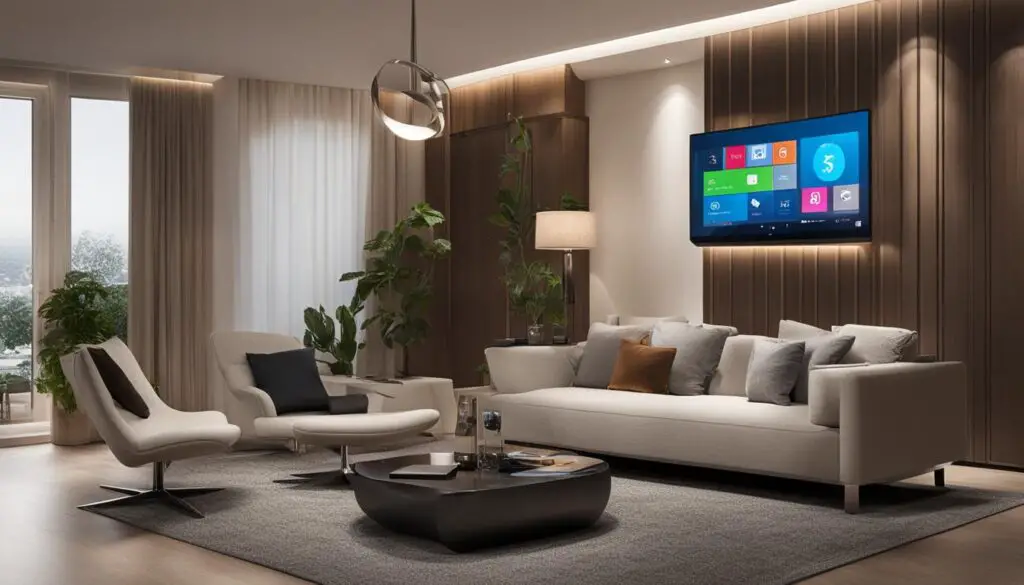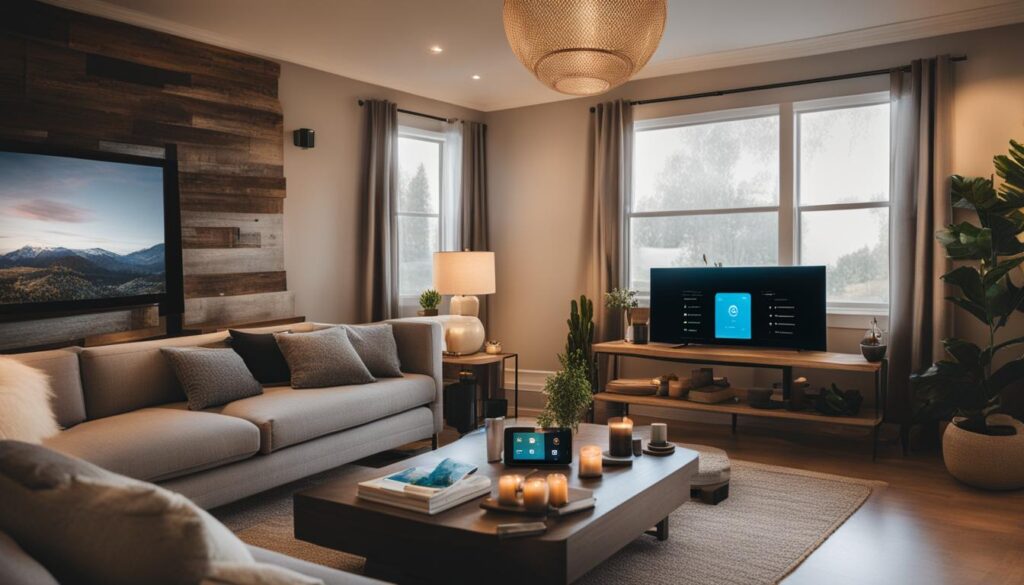Creating a smart home doesn’t have to break the bank. In this guide, I will provide you with tips and tricks on how to automate your home on a budget. From smart speakers to smart plugs, we’ll explore affordable options that can enhance your living space without costing a fortune. With these cost-effective home automation solutions, you can enjoy the convenience and efficiency of a smart home without overspending.
Table of Contents
Key Takeaways:
- Automating your home doesn’t have to be expensive.
- There are budget-friendly options available for smart home automation.
- Choose the right smart devices under $100 to get started.
- Consider affordable smart lighting solutions for added convenience.
- Invest in cost-effective smart security cameras for peace of mind.
Choosing the Right Smart Home Devices Under $100
To create an automated home on a budget, it’s important to choose the right smart devices that are both affordable and reliable. There are plenty of options available for under $100 that can bring automation to your home. From smart speakers to smart plugs, we’ll explore the best inexpensive smart home devices that can transform your living space without breaking the bank.
Smart Speakers
Smart speakers are a great starting point for building your budget-friendly smart home. With voice control capabilities, they allow you to easily interact with other smart devices and manage your home automation system.
| Smart Speaker | Price | Key Features |
|---|---|---|
| Amazon Echo Dot | $49.99 | Hands-free voice control, compact design |
| Google Nest Mini | $49.99 | Google Assistant integration, improved sound quality |
Smart Plugs
Smart plugs are an affordable way to convert your non-smart devices into smart ones. By simply plugging them into a standard electrical outlet, you can control the power supply remotely and schedule device usage.
| Smart Plug | Price | Key Features |
|---|---|---|
| Wemo Mini Smart Plug | $24.99 | Voice control, works with Alexa and Google Assistant |
| Kasa Smart Wi-Fi Plug | $19.99 | Energy monitoring, app control |
By selecting smart speakers like the Amazon Echo Dot or Google Nest Mini, and pairing them with smart plugs such as the Wemo Mini Smart Plug or Kasa Smart Wi-Fi Plug, you can easily control your lights, appliances, and more, all under $100.

“Choosing the right smart home devices on a budget is a smart investment that brings convenience and efficiency to your daily life.”
When considering affordable smart home gadgets, it’s essential to research customer reviews, compare features, and ensure compatibility with your existing devices. By making informed choices and leveraging the power of automation, you can transform your home into a smart haven without breaking the bank.
Affordable Smart Lighting Solutions for Your Home
Smart lighting is a game-changer when it comes to home automation on a budget. With the ability to control your lights with a simple voice command or through a smartphone app, it adds convenience and efficiency to your daily life. Thankfully, there are numerous affordable options available that won’t put a dent in your wallet.
One popular choice for budget-friendly smart lighting is Philips Hue. Known for its quality and reliability, Philips Hue offers a range of smart bulbs priced under $50. With dimming capabilities and a wide range of color options, you can easily create the perfect ambiance for any occasion.
Another affordable option to consider is Wyze smart bulbs. These low-cost smart lights not only provide various lighting options but also come with energy-efficient features, allowing you to save on electricity bills. The Wyze bulbs offer seamless integration with popular voice assistants like Amazon Alexa and Google Assistant, making it easy to control your lights with just your voice.
Sengled is yet another brand that offers cheap yet reliable smart lighting solutions. Their smart bulbs are priced under $50 and boast features like dimming, scheduling, and color-changing capabilities. With Sengled’s affordable smart bulbs, you can transform your home into a smart haven without breaking the bank.

With these budget-friendly smart bulbs, you can effortlessly automate and personalize your home’s lighting system. From setting the mood for a relaxing movie night to ensuring a well-lit home when you return, smart lighting adds both convenience and security to your space.
Cost-Effective Smart Security Camera Options
Keeping your home secure doesn’t have to be expensive. There are plenty of affordable smart security cameras available under $100 that can help you monitor your property and provide peace of mind. Brands like Nest, Ring, Blink, and Wyze offer budget-friendly options that deliver high-quality video and convenient features.
With motion detection capabilities, these smart cameras can alert you to any suspicious activity around your home. They also come equipped with two-way audio, allowing you to communicate with visitors or deter potential intruders. Whether you’re at work or on vacation, these low-cost surveillance cameras offer around-the-clock monitoring so you can keep an eye on your home without breaking the bank.
Featuring easy installation and user-friendly mobile apps, these smart cameras under $100 make it simple to set up and customize your security system. Whether you’re a tech-savvy homeowner or a novice, these affordable options are designed to provide seamless integration with your existing smart home devices.
| Brand | Price | Key Features |
|---|---|---|
| Nest | Under $100 | High-quality video, motion detection, two-way audio |
| Ring | Under $100 | 1080p HD video, customizable motion zones, live view |
| Blink | Under $100 | Wireless, battery-powered, easy to install |
| Wyze | Under $100 | Two weeks of free cloud storage, night vision, voice control |
With these cost-effective smart security cameras, you can rest assured knowing that your home is protected without draining your budget. Take advantage of the affordable options available in the market today and enjoy the peace of mind that comes with a well-monitored and secure home.
The Importance of Smart Home Compatibility and Integration
When building a budget-friendly smart home, it’s crucial to consider smart home compatibility and seamless integration of compatible smart devices. By investing in devices that work well with each other, you can ensure a seamless and streamlined experience, making your home automation journey more cost-effective.
Brands like Apple HomeKit, Alexa, and Google Home offer a range of compatible gadgets that can be easily integrated into your smart home system. These brands have a wide selection of smart devices, from smart speakers and thermostats to lighting systems and security cameras, all designed to work together harmoniously. By prioritizing compatibility, you can save money and avoid compatibility issues down the line.
When selecting smart devices, look for compatibility indicators such as “Works with Apple HomeKit,” “Compatible with Alexa,” or “Works with Google Home.” These indicators ensure that the devices can be seamlessly linked and controlled through a central hub or app.
Seamless integration not only simplifies the management of your smart home but also opens up possibilities for automation and smart routines. For example, you can create customized scenes that activate multiple devices simultaneously with a simple voice command or a tap on your smartphone. This level of integration enhances the overall smart home experience and makes your daily routines more efficient and convenient.
“Smart home compatibility and integration are fundamental in creating a cohesive and functional smart home ecosystem. By choosing compatible smart devices and seamlessly integrating them, homeowners can unlock the full potential of their smart home automation, enjoying convenience, comfort, and energy savings.”
To showcase the importance of smart home compatibility and integration, take a look at the table below, which highlights some leading brands and their compatible smart devices:
| Brands | Compatible Smart Devices |
|---|---|
| Apple HomeKit | HomePod, Apple TV, Apple Watch, Philips Hue bulbs, August Smart Lock |
| Alexa | Amazon Echo speakers, Ring Video Doorbell, Ecobee thermostats, Philips Hue bulbs, TP-Link smart plugs |
| Google Home | Google Nest Mini, Google Nest Hub, Philips Hue bulbs, Nest Thermostats, TP-Link smart switches |
The wide range of compatible smart devices from these brands ensures that you have various options to choose from, meeting your specific needs and preferences while maintaining complete compatibility. Whether you’re looking to automate your lighting, enhance security, or control your home’s temperature, there are smart devices available for seamless integration into your smart home system.
By prioritizing smart home compatibility and integrating compatible smart devices, you can build a budget-friendly smart home that offers enhanced functionality, convenience, and control.
Tips for Building a Budget-Friendly Smart Home Network
Building a budget-friendly smart home network is essential to ensure a seamless automation experience. By implementing the right strategies and choosing the right devices, you can create an efficient and cost-effective network that meets your home automation needs. Here are some tips to help you build a budget-friendly smart home network:
1. Select a Reliable Wi-Fi Router
Start by choosing a reliable Wi-Fi router that can handle the demands of your smart devices. Look for routers that offer a strong signal, sufficient coverage, and advanced features like beamforming and dual-band support. This will help ensure a stable and fast connection for all your smart home devices.
2. Consider Using Smart Hubs
Smart hubs, such as SmartThings or Wink, can centralize the control of your smart home devices and reduce the strain on your Wi-Fi network. These hubs act as a bridge between your devices, allowing them to communicate with each other and reducing the amount of data transmitted over Wi-Fi. This can help improve the overall performance of your smart home network.
3. Utilize Voice Control with Smart Speakers or Displays
Take advantage of voice control by using smart speakers or smart displays. Devices like Amazon Echo or Google Nest Hub can simplify device control by allowing you to use voice commands. You can easily control your smart devices, set up routines, and even check the status of your devices through voice commands. This not only adds convenience but also reduces the need for additional physical controllers.
4. Optimize Network Placement and Signal Strength
Ensure that your smart home devices are strategically placed within your home to optimize network connectivity and signal strength. Avoid placing devices in areas with significant obstacles or interference, such as thick walls or metal structures. Additionally, you can consider using Wi-Fi range extenders or mesh network systems to enhance coverage and eliminate dead spots.
5. Regularly Update Firmware and Security Settings
Keep your smart home network secure and up to date by regularly updating the firmware of your devices and adjusting security settings. Manufacturers often release firmware updates that address security vulnerabilities and improve device performance. Additionally, consider implementing strong and unique passwords, enabling two-factor authentication, and using virtual private networks (VPNs) for added security.
By implementing these tips, you can effectively build a budget-friendly smart home network that provides reliable connectivity and seamless automation. With the right devices and network setup, you can enjoy the benefits of home automation without exceeding your budget.
Conclusion
In conclusion, automating your home on a budget is not only achievable but also a smart way to enhance your living space without overspending. By carefully selecting affordable smart devices, prioritizing compatibility, and building a cost-effective network, you can create a budget-friendly smart home that brings convenience and efficiency to your daily life.
Remember to consider the wide range of inexpensive smart home options available, such as smart speakers, smart plugs, smart lighting, and smart security cameras. By choosing the right devices, you can transform your home into a modern, connected space without breaking the bank.
Additionally, it’s important to prioritize compatibility and integration when building your budget-friendly smart home. Investing in devices that work well together will ensure a seamless experience and prevent compatibility issues down the line. Brands like Apple HomeKit, Alexa, and Google Home offer a variety of compatible devices that can easily integrate into your smart home system.
So, don’t let a limited budget hold you back from enjoying the benefits of home automation. With the tips and tricks provided in this guide, you can unlock the potential of affordable smart home solutions and create a more convenient and efficient living environment. Start exploring the world of budget-friendly automation today and enjoy the ease and comfort it brings to your daily life.
FAQ
How can I automate my home on a budget?
To automate your home on a budget, start by choosing affordable smart devices under $100. Consider options like smart speakers, smart plugs, and smart bulbs that offer convenience without breaking the bank.
What are some budget-friendly smart home devices under $100?
Some budget-friendly smart home devices under $100 include smart speakers like Amazon Echo Dot and Google Nest Mini, smart plugs from popular brands like Wemo and Kasa, and smart security cameras from Nest, Ring, Blink, and Wyze.
How can I install affordable smart lighting in my home?
You can install affordable smart lighting in your home by using smart bulbs from brands like Philips Hue, Wyze, and Sengled, all priced under $50. These smart bulbs offer features like dimming, color changing, and energy efficiency.
Are there any cost-effective smart security camera options available?
Yes, there are plenty of cost-effective smart security camera options available. Brands like Nest, Ring, Blink, and Wyze offer smart security cameras under $100 that provide high-quality video, motion detection, and two-way audio.
Why is compatibility and integration important in smart home automation?
Compatibility and integration are important in smart home automation to ensure a seamless experience. Investing in devices that work well together and are compatible with each other will save you money and prevent compatibility issues down the line.
What are some tips for building a budget-friendly smart home network?
When building a budget-friendly smart home network, start by selecting a reliable Wi-Fi router that can handle the demands of your smart devices. Consider using smart hubs like SmartThings or Wink to connect your devices and reduce strain on your Wi-Fi network.


